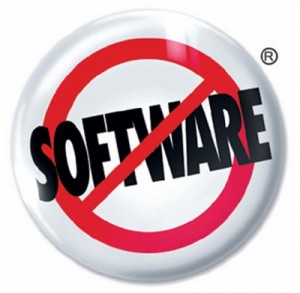The eulogies have been written: downloaded software is dead with the advent of tablets and smartphones. Apps are the future and we don’t need desktop computers anymore.
Well, let the naysayers howl because downloaded software is alive and kicking, and smartphones and tablets are actually adding to the software industry. So if you are a software developer pay attention to changes in the market. Take advantage of these changes in order to disrupt your own business before someone else does!

Ten years ago, people talked about the death of software in retail stores due to the emergence of affordable high speed internet access at home. TechCrunch even published a story on the death of packaged software (and inherently the rise of the digital download) as recently as November 2008. Although we can agree that retail boxed software is a declining market in 2012, it still isn’t dead as evidenced by Best Buy’s online store selling software where you can “Check Shipping and Availability.”
So if you don’t believe me that digital downloads are going to be around for a while, here’s my case for you:
Tablets Adding to Market Size
Forrester released a research report last year titled “The Products That Lose When Tablets Win” which included a section on how different age brackets use their iPad/tablet devices in situations when a consumer has both a tablet and a desktop/laptop computer. The graph below indicates that although a healthy percentage (30%) of people are using their tablet more than their laptop when both are available, only a relatively small percentage of users bought their iPad/Tablet as a replacement for their laptop or eReader.

This trend may accelerate over time as tablets increase in sophistication and function through innovation, as pointed out in this article from Fast Company. But I doubt that within the next five years businesses will replace a meaningful percentage of laptops or desktops for their employees. For any readers that have worked at organizations with an IT department, think about how rapidly new technology gets adopted.
On the consumer side, I would argue that this trend is a more likely phenomenon. In the next few years there will be a greater number of people that never owned a laptop or desktop for personal use, but they will own tablets and smartphones. If the total number of hardware devices in the market is increasing, then software programs, whether digital download or app or SaaS are also going to increase.
App Sales Adding to Software Market
Forrester also estimated the growth of the app sales market from 2010 through 2015 in a report titled “Mobile App Internet Recasts The Software And Services Landscape.”

Apps have received lots of media attention the last few years. Apple and Android may each have over 500,000 apps in their marketplaces with more and more people buying apps at $0.99 up to $9.99.
But can a $5 app on your tablet or phone really do the same thing as that $199 PDF creator on your laptop? Unlikely.
Sure there will be some products that are unnecessary on a tablet, but there’s also going to be a new market of software apps that are not relevant to a laptop and desktop crowd.
Apps like Tripit and Dropbox are not true apps in that those products exist on non-tablet and phone devices. These programs are really SaaS services, but does anyone doubt that there will be innovation in apps where someone will find a product to attract 5 million paid users? I don’t. Note that Forrester predicts this market will be valued at $19 billion by 2013.
SaaS Products Adding to Software Market
 Many people are touting the virtues of companies like Salesforce.com (CRM) and Zendesk (Support) as the death knell for software. Salesforce’s website even has the cute “No Software” icon to indicate that people shouldn’t be downloading software anymore – only use cloud based software. Unfortunately for Salesforce, while cloud hosted software does have many virtues, it is not right for every single organization in every situation.
Many people are touting the virtues of companies like Salesforce.com (CRM) and Zendesk (Support) as the death knell for software. Salesforce’s website even has the cute “No Software” icon to indicate that people shouldn’t be downloading software anymore – only use cloud based software. Unfortunately for Salesforce, while cloud hosted software does have many virtues, it is not right for every single organization in every situation.

Forrester’s report “Which Software Markets Will SaaS Disrupt,” beautifully outlines the markets that SaaS has disrupted, likely will disrupt, may disrupt and won’t disrupt both in 2010 and by 2013.
Digging into the data a bit, SaaS has already disrupted some software categories (webconferencing, talent management and recruitment management), will likely disrupt other software categories by 2013 (content security, time and attendance, and expense reporting) and will leave still other categories virtually untouched by 2013 (core business intelligence, office productivity software and electronic design automation).
Furthermore, as you can see from the graphic, while SaaS is not only growing as a percentage of the software market, the software market itself is growing by almost 35 percent. So SaaS may be taking a bigger piece of the pie, it’s still only 17 percent and the overall pie is growing fast.
Conclusion
Take a $350+ billion perpetual license market, add $35+ billion SaaS market and $19 billion App market and what do you have? A growing diversity in the software market that is tied to the perpetual license model for a long time to come. Does that mean that you should ignore a SaaS business model for your products or explore debundling your product for the Apps market? I wouldn’t!
As Mark Twain once said, “The reports of my death have been greatly exaggerated.” Well, ten years after the obituaries where written for packaged retail software it is still hanging on. So don’t count out the downloaded perpetual license market anytime soon.
Keystone
The software market, despite cries from many directions, is growing larger and larger. If you don’t adapt your software business to the technological changes, your business can be readily disrupted even with the overall market growing for years to come.
P.S. Gartner predicts that worldwide PC shipments will grow 4.4 percent in 2012. Here’s a link to the article that explains emerging markets are the near future of PC growth due to an existing lack of penetration, but that’s an article for another time.
Pingback: Who Killed Download Software? Or are the rumours not true…. | Dan Sodergren